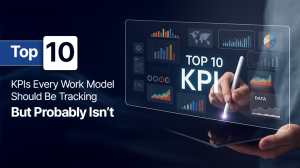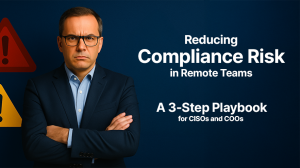Table of Contents
The lack of a good monitoring system is progressively destroying your company’s revenue. It leads to lower results, workflow gaps, missed deadlines, and burnout among unproductive workforces. In Q4 2024, the average US business lost more than $2.7 billion per day due to productivity loss and absenteeism.
With the emergence of artificial intelligence and cutting-edge technologies, employee monitoring has become easier than ever. However, even in 2025, many businesses are unaware of how to monitor employee productivity.
Whether you have a remote, hybrid, or in-house staff, measuring employee productivity provides insight into how, where, and when the workforce is at its optimal performance.
They can use dependable employee management systems to track workforce activity, leaves, and productivity patterns. It focuses on key performance metrics to analyze workforce activity and provide real-time reports.
Keep reading to know how to monitor employee productivity, what are the KPIs, challenges, and best practices so you can improve workforce efficiency.

Struggling with Blind Spots in Team Performance?
wAnywhere gives you the visibility you need to spot inefficiencies and take action — before it impacts deadlines or morale.
Why Employee Productivity Matters for Business
Employee productivity has a direct impact on how efficiently your organization performs. When teams are productive, projects finish on time, and resources are allocated efficiently.
However, low productivity sets off a chain reaction of missed deadlines, postponed projects, dissatisfied clients, and increased expenditure. Many companies fail to recognize early symptoms of reduced production.
For example, a marketing agency may see that campaign schedules are sliding, but without data, they cannot determine why. Is it bad time management? Is it unclear who owns which tasks?
High-performing individuals may become annoyed working with unmotivated coworkers, whilst underperformers may go unnoticed.
5 KPIs to Measure Employee Productivity
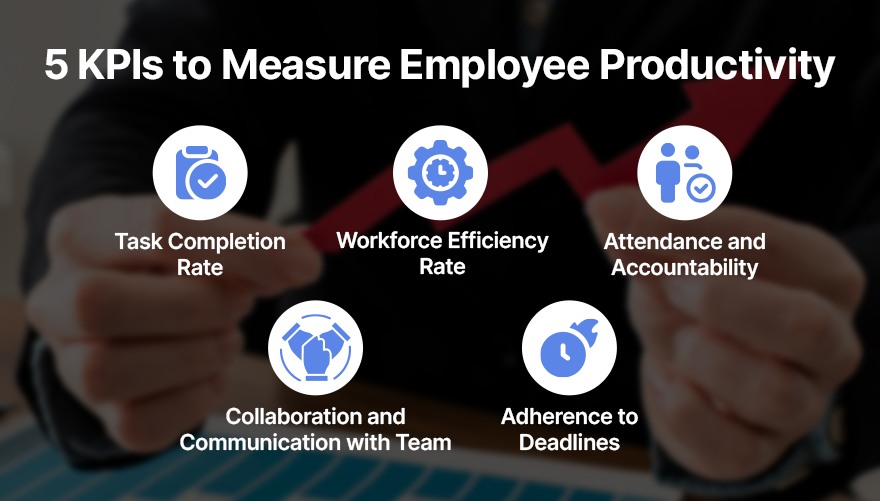
Tracking the correct KPIs enables managers to address gaps and boost performance without micromanaging. Here are five critical KPIs that every organization should leverage.
Task Completion Rate
It indicates how effectively employees handle their workload and duties. A constant completion rate suggests great performance; however, frequent delays may reveal process inefficiencies or imprecise work assignments.
It also helps with planning by identifying workloads, which allows managers to balance work and avoid overburdening certain team members.
Workforce Efficiency Rate
It focuses on how efficiently employees complete their tasks, rather than how busy they appear. A high-efficiency rate indicates streamlined operations, effective time management, and the utilization of relevant tools or support systems.
A low rate, on the other hand, could indicate workflow bottlenecks, out-of-date technologies, or inadequate training.
This KPI is critical for recognizing performance patterns across teams and ensuring that time and resources are utilized to their best capacity.
Attendance and Accountability
It evaluates how consistently employees show up for work and whether they take responsibility for their tasks and deadlines. This metric helps distinguish between those who are merely present and those who are actively contributing.
It also addresses patterns of absenteeism or disengagement, helping HR and management take proactive steps. Regular monitoring of attendance and accountability supports a culture of ownership and responsibility across the team.
Collaboration and Communication with Team
Strong communication improves project flow, reduces misunderstandings, and fosters a more positive work environment. Poor collaboration, on the other hand, can lead to delays, duplicated efforts, and team friction.
Managers can identify employees who are active contributors versus those who may need guidance by tracking this metric. It also supports cross-functional teamwork, helping ensure everyone stays aligned on shared goals and project expectations.
Adherence to Deadlines
Missing deadlines affects not only individual productivity but also overall team efficiency and client satisfaction.
This KPI provides insights into whether workloads are realistic or if support systems are needed. Regular tracking ensures accountability and helps managers spot patterns early, allowing for timely interventions to prevent delays and maintain smooth project delivery.
3 Common Challenges in Monitoring Employee Productivity
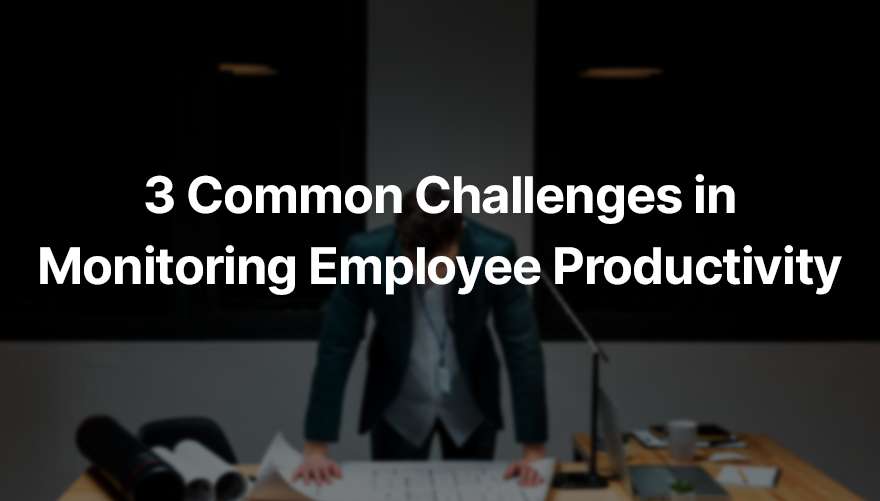
Lack of Clear Goals
Employees struggle to comprehend what is expected of them when goals are not clearly defined. This causes confusion, lowers motivation, and makes it harder to assess achievement. When expectations are unclear, even the most prolific employees may fail to offer meaningful outcomes.
Without them, productivity measurements lose meaning, and performance evaluations become inconsistent. To successfully evaluate efficiency, goals must be measurable, time-bound, and integrated with the company’s overall strategy.
Micro-management
Micromanagement is frequently motivated by a desire to regulate performance, but it ultimately harms employee morale. Constant oversight can make employees feel undervalued, resulting in low morale and slower performance. Micromanagement frequently fails to improve efficiency.
Distractions
High workloads, numerous notifications, and a lack of mental breaks can cause distraction and burnout. These factors can drastically impact an employee’s productivity over time.
Monitoring methods that prioritize output over employee well-being may ignore this issue. Burnout also raises turnover rates and healthcare expenditures. Managers must notice warning signs early and strike a balance between productivity objectives and mental health.
Encouraging realistic deadlines, regular breaks, and open communication reduces stress and enhances team productivity over time.
Read more: 6 Best Employee Monitoring Software in 2026
4 Best Practices to Monitor and Improve Employee Productivity
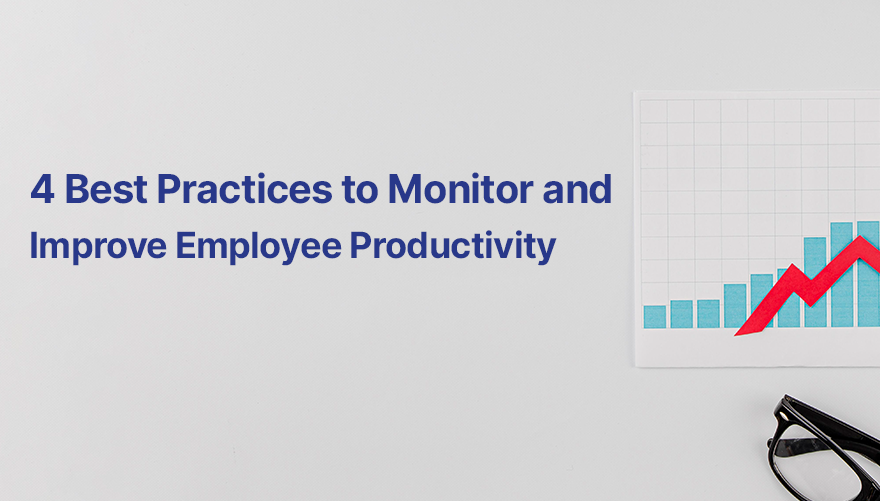
Businesses must prioritize results, communication, and modern technologies to increase productivity and establish a healthier work environment for their employees.
Create a Clear Goal for Workforce
Employees can remain engaged and motivated when they understand what they are working toward. Clear goals provide direction and allow managers to measure performance with more accuracy. Each goal should be specific, measurable, and aligned with the company’s objectives. Employees are more engaged when they understand how their work contributes to their work.
Use Reliable Employee Monitoring Tools
The right monitoring software can provide real-time data on task progress, time spent on projects, and employee engagement without invading privacy. These tools help managers identify workflow bottlenecks, optimize schedules, and support underperforming team members.
Look for features like time tracking, productivity reports, and integration with existing systems. A reliable monitoring system creates transparency and reduces the guesswork in evaluating employee performance.
Encourage Task and Time Management
Helping employees develop strong task and time management skills leads to better productivity. Without these skills, even high-performing teams can fall behind due to time-wasting habits.
Encourage teams to break down complex tasks, and leverage productivity methods, like the Pomodoro technique or time blocking. Managers can support this by offering training, templates, or employee management tools. Promoting better time habits not only improves output but also reduces stress and burnout.
Conduct Regular Transparent Feedback With Team
These meetings or surveys should focus on progress, roadblocks, and upcoming tasks, not just performance reviews. When employees are part of an open feedback loop, they feel heard and more engaged in their work.
Transparent check-ins also allow managers to adjust goals, redistribute workloads, and offer support where needed. These sessions build trust and reduce misunderstandings. When done regularly and with empathy, check-ins can strengthen team collaboration and ensure productivity stays on track without adding pressure.
Read more: Measuring Employee Performance: Understanding Key Metrics for Business Owners
Monitor Employee Productivity with wAnywhere
If you are wondering how to track employee productivity without surveillance or micromanagement, wAnywhere serves your purpose. This one-stop productivity and compliance platform is purpose built to give actionable workforce analytics you need to make your teams better, transparent, and focused.
Whether you want to analyze work trends, compare which teams or individuals are performing well, or measure productive and unproductive activities at every moment, wAnywhere gives you real-time insights so you can take decisions based on data not guess work. It helps you to enhance visibility, optimize workflows, boost security, balance resources, and improve overall well-being and productivity of your workforce.
Read more: 5 Effective Ways to Monitor Employee Performance
Conclusion
While today’s work preference shifts to remote and hybrid setups, many businesses are in a dilemma: how to monitor employee productivity without micromanaging. Thanks to employee monitoring software or productivity tracking tools, you can now measure productivity of your workforce without adding a task to your routine. Monitoring employee productivity is a critical task that requires more than just tracking hours or activity. However, to truly understand performance, businesses need tools that provide clear, accurate insights into how work is progressing and where improvements are needed.

Discover How to Monitor Employee Productivity & Boost Team Efficiency
With wAnywhere, track key metrics, reduce burnout, and improve outcomes across remote, hybrid, or on-site teams.


